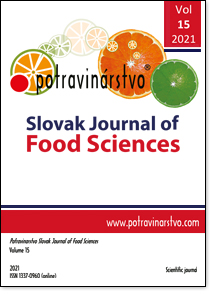The effect of heat-moisture treatment conditions on the structure properties and functionalities of potato starch
DOI:
https://doi.org/10.5219/1647Keywords:
potato starch, heat moisture treatment, structures properties, physicochemical properties, in vitro digestibilityAbstract
Potato starch was modified via heat-moisture treatment (HMT) under various reaction conditions. The effect of HMT on structural, physicochemical, and in vitro digestibility were investigated. HMT led to the rupture, adhesion and partial gelatinization, and agglomeration of the granules which surface became rougher, thereby increasing the particle size and resulting in the hollow structure located at the hilum of potato starch granules. XRD results showed an increased relative crystallinity and transformed crystalline structure from B-type to C-type with the extension of heat moisture treatment. FTIR spectroscopy results indicated that HMT might cause additional interactions between amylose-amylose, and/or amylose-amylopectin and/or amylopectin-amylopectin chains, which eventually leads to the increase of the mass of the carbonyl group and a hydroxyl group. HMT significantly decreased the peak viscosity, hold viscosity, and breakdown viscosity of starch, while the gelatinization temperature increased. The tHMT1, THMT100, and CHMT15 had the lowest content of RDS and there was no significant difference between the three samples, that is these three samples had the highest total content of SDS and RS.
Downloads
Metrics
References
Colussi, R., Singh, J., Kaur, L., Zavareze, E. R., Dias, Á. R. G., Stewart, R. B., Singh, H. 2017. Microstructural characteristics and Gastro-small Intestinal Digestion In Vitro of Potato Starch: Effects of Refrigerated Storage and Reheating in Microwave. Food Chemistry, vol. 226, p. 171-178. https://doi.org/10.1016/j.foodchem.2017.01.048 DOI: https://doi.org/10.1016/j.foodchem.2017.01.048
Dankar, I., Haddarah, A., El Omar, F., Pujola, M., Sepulcre, F. 2018. Characterization of food additive-potato starch complexes by FTIR and X-ray diffraction. Food Chemistry, vol. 206, p. 7-12. https://doi.org/10.1016/j.foodchem.2018.03.138 DOI: https://doi.org/10.1016/j.foodchem.2018.03.138
Karim, A. A., Nadiha, M. Z., Chen, F. K., Phuah, Y. P., Chui, Y. M., Fazilah, A. 2008. Pasting and retrogradation properties of alkali-treated sago (Metroxylon sagu) starch. Food Hydrocolloids, vol. 22, p. 1044-1053. https://doi.org/10.1016/j.foodhyd.2007.05.011 DOI: https://doi.org/10.1016/j.foodhyd.2007.05.011
Kizil, R., Irudayaraj, J., Seetharaman, K. 2002. Characterization of irradiated starches by using FT-Raman and FTIR spectroscopy. J. Agric. Food Chem., vol. 50, no. 14, p. 3912-3918. DOI: https://doi.org/10.1021/jf011652p
Li, G. 2018. Sweet potato starch modified by branching enzyme, b-amylase and transglucosidase. Food Hydrocolloids, vol. 83, p. 182-189. https://doi.org/10.1016/j.foodhyd.2018.05.005 DOI: https://doi.org/10.1016/j.foodhyd.2018.05.005
Li, G., Jiahao, L., Hui, L., Yu, Z., Bo, C. 2020. The structure property and adsorption capacity of new enzyme-treated potato and sweet potato starches. International Journal of Biological Macromolecules, vol. 144, p. 863-873. https://doi.org/10.1016/j.ijbiomac.2019.09.164 DOI: https://doi.org/10.1016/j.ijbiomac.2019.09.164
Li, S., Ward, R., Gao, Q. 2011. Effect of heat-moisture treatment on the formation and physicochemical properties of RS from mung bean (Phaseolus radiatus) starch. Food Hydrocolloids, vol. 25, no. 7, p. 1702-1709. https://doi.org/10.1016/j.foodhyd.2011.03.009 DOI: https://doi.org/10.1016/j.foodhyd.2011.03.009
Liao, L., Wu, W. 2016. Relationship between gelatinization and gel properties of different starch and their noodles. Transaction of the Chinese Society of Agricultural Engineering, vol. 30, no. 15, p. 332-338. https://doi.org/10.3969/j.issn.1002-6819.2014.15.042
Liu, D., Traverse, C. J., Chen, P., Elinski, M., Yang, C., Wang, L., Young, M., Lunt, R. R. 2018. Aqueous‐Containing Precursor Solutions for Efficient Perovskite Solar Cells. Adv. Sci. (Weinh), vol. 5, no. 1, p. 1700484. https://doi.org/10.1002/advs.201700484 DOI: https://doi.org/10.1002/advs.201700484
Lu, Y., Luthria, D., Fuerst, E. P., Kiszonas, A. M., Yu, L., Morris, C. F. 2014. Effect of Processing on Phenolic Compostion of Dough and Bread Fractions Made from Refined and Whole Wheat Flour of Three Wheat Varieties. Journal of Agricultural and Food Chemistry, vol. 62, no. 43, p. 10431-10436. https://doi.org/10.1021/jf501941r DOI: https://doi.org/10.1021/jf501941r
NidhiDangi, Baljeet S. Y, Ritika, B. Y. 2019. Pasting, rheological, thermal and gel textural properties of pearl millet starch as modified by guar gum and its acid hydrolysate. International Journal of Biological Macromolecules, vol. 139, p. 387-396. https://doi.org/10.1016/j.ijbiomac.2019.08.012 DOI: https://doi.org/10.1016/j.ijbiomac.2019.08.012
Sui, Z., Yao, T., Zhao, Y., Ye, X., Kong, X., Ai, L. 2015. Effects of heat-moisture treatment reaction conditions on the physicochemical and structural properties of maize starch: Moisture and length of heating. Food Chemistry, vol. 173, p. 1125-1132. https://doi.org/10.1016/j.foodchem.2014.11.021 DOI: https://doi.org/10.1016/j.foodchem.2014.11.021
Thakur, R., Pristijono, P., Scarlett, C. J., Bowyer, M., Singh, S., Vuong, Q. V. 2019. Starch-based films: Major factors affecting their properties. International Journal of Biological Macromolecules, vol. 132, p. 1079-1089. https://doi.org/10.1016/j.ijbiomac.2019.03.190 DOI: https://doi.org/10.1016/j.ijbiomac.2019.03.190
Wang, Y., Wang, L., Zhou, X., Hu, S., Chen, H., Xiang, J., Zhang, Y., Zeng, Y., Shi, Q., Zhu, D., Zhang, Y. 2019. Research Progress on Heat Stress of Rice at Flowering Stage. Rice Science, vol. 26, no. 1, p. 1-10. https://doi.org/10.1016/j.rsci.2018.06.009 DOI: https://doi.org/10.1016/j.rsci.2018.06.009
Xie, H., Gao, J., Xiong, X., Gao, Q. 2018. Effect of heat-moisture treatment on the physicochemical properties and in vitro digestibility of the starch-guar complex of maize starch with varying amylose content. Food Hydrocolloids, vol. 83, p. 213-221. https://doi.org/10.1016/j.foodhyd.2018.04.038 DOI: https://doi.org/10.1016/j.foodhyd.2018.04.038
Zhao, S.-Y., Chen, Z.-Y., Wei, N., Liu, L., Han, Z.-B. 2019. Highly Efficient Cooperative Catalysis of Single-Site Lewis Acid and Brønsted Acid in a Metal–Organic Framework for the Biginelli Reaction. Inorg. Chem., vol. 58, no. 12, p. 7657-7661. https://doi.org/10.1021/acs.inorgchem.9b00816 DOI: https://doi.org/10.1021/acs.inorgchem.9b00816
Published
How to Cite
Issue
Section
License
Copyright (c) 2021 Potravinarstvo Slovak Journal of Food Sciences

This work is licensed under a Creative Commons Attribution 4.0 International License.
This license permits non-commercial re-use, distribution, and reproduction in any medium, provided the original work is properly cited, and is not altered, transformed, or built upon in any way.






























